Eng 105 topic 1 dq 3 Study guides, Class notes & Summaries
Looking for the best study guides, study notes and summaries about Eng 105 topic 1 dq 3? On this page you'll find 62 study documents about Eng 105 topic 1 dq 3.
Page 4 out of 62 results
Sort by
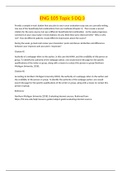
-
ENG 105 Topic 5 DQ 3
- Case • 1 pages • 2020
-
- $10.49
- 1x sold
- + learn more
ENG 105 Topic 5 DQ 3 Provide a sample in-text citation that you plan to use in your evaluation essay you are currently writing. Use one of the head/body/tail combinations from our textbook (Chapter 2). Then create a second citation for the same source, but use a different head/body/tail combination. As the week progresses, comment on your class mates' in-text citations. Do you think they were cited correctly? Why or why not? How do different patterns create different impressions about the ...
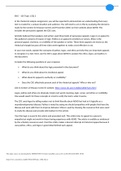
-
ENG 105 Topic 1 DQ 3 ENG – 105 Topic 1 DQ 3 In the rhetorical analysis assignment, you will be expected to demonstrate an understanding that every text is created for a unique situation and audience. You will need to act on this by analyzing the decisions
- Case • 1 pages • 2022
-
- $11.39
- + learn more
ENG 105 Topic 1 DQ 3 ENG – 105 Topic 1 DQ 3 In the rhetorical analysis assignment, you will be expected to demonstrate an understanding that every text is created for a unique situation and audience. You will need to act on this by analyzing the decisions made by the Centers for Disease Control and Prevention (CDC) on their website about ADHD. This includes the persuasive appeals the CDC uses. Aristotle believed that speakers and writers used three kinds of persuasive appeals. Logos is an app...

-
ENG – 105 Topic 1 DQ 1 | VERIFIED SOLUTION
- Case • 1 pages • 2021
-
- $5.00
- + learn more
ENG – 105 Topic 1 DQ 1 Take a moment to reflect on past writing experiences from your academic, personal, or professional life. Answer the following questions as your initial post. Plan to have 150-200 words. 1. What was writing like for you as a child or young adult? Do you recall any vivid writing experiences? 2. How do you currently use writing in academic, personal, and professional experiences? 3. How might writing be used in future academic, personal, and professional experiences?
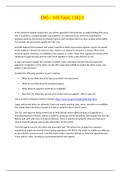
-
ENG 105 Topic 1 DQ 3
- Case • 2 pages • 2020
- Available in package deal
-
- $10.49
- + learn more
ENG 105 Topic 1 DQ 3 In the rhetorical analysis assignment, you will be expected to demonstrate an understanding that every text is created for a unique situation and audience. You will need to act on this by analyzing the decisions made by the Centers for Disease Control and Prevention (CDC) on their website about ADHD. This includes the persuasive appeals the CDC uses. Aristotle believed that speakers and writers used three kinds of persuasive appeals. Logos is an appeal to the audience’s ...
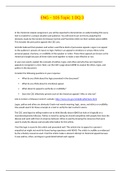
-
ENG 105 Topic 1 DQ 3
- Case • 2 pages • 2020
- Available in package deal
-
- $10.49
- + learn more
ENG 105 Topic 1 DQ 3 In the rhetorical analysis assignment, you will be expected to demonstrate an understanding that every text is created for a unique situation and audience. You will need to act on this by analyzing the decisions made by the Centers for Disease Control and Prevention (CDC) on their website about ADHD. This includes the persuasive appeals the CDC uses. Aristotle believed that speakers and writers used three kinds of persuasive appeals. Logos is an appeal to the audience’s ...

-
ENG 105 Topic 2 DQ 2
- Case • 2 pages • 2022
-
- $7.49
- + learn more
ENG 105 Topic 2 DQ 2 Review the CDC website and answer at least three of the questions below: 1. Who is the writer? 2. What is the writer’s purpose? 3. Who is the intended audience? 4. What is the broader cultural context that motivated the writing of the article? 5. How does the writer establish ethos? 6. Does the writer appeal to logos (logic)? 7. Does the writer appeal to pathos (emotions)? 8. Do you feel that the website is effective? Why or why not? Use these questions to gui...

-
ENG – 105 Topic 1 DQ 3
- Case • 2 pages • 2022
-
- $7.49
- + learn more
ENG – 105 Topic 1 DQ 3 In the rhetorical analysis assignment, you will be expected to demonstrate an understanding that every text is created for a unique situation and audience. You will need to act on this by analyzing the decisions made by the Centers for Disease Control and Prevention (CDC) on their website about ADHD. This includes the persuasive appeals the CDC uses. Aristotle believed that speakers and writers used three kinds of persuasive appeals. Logos is an appeal to the audienc...
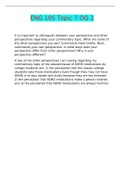
-
ENG 105 Topic 7 DQ 2
- Case • 2 pages • 2022
-
- $7.49
- + learn more
ENG 105 Topic 7 DQ 2 It is important to distinguish between your perspective and other perspectives regarding your commentary topic. What are some of the other perspectives you see? Summarize them briefly. Next, summarize your own perspective. In what ways does your perspective differ from other perspectives? Why is your perspective different? A few of the other perspectives I am seeing regarding my commentary topic of the abuse/misuse of ADHD medications by college students are; 1) the perc...

-
ENG – 105 Topic 1 DQ 2
- Case • 3 pages • 2022
-
- $7.49
- + learn more
ENG – 105 Topic 1 DQ 2 Read the Centers for Disease Control and Prevention’s page on ADHD; the link is provided below. Use the close reading techniques described in Chapter 1 of the e-book. It may be helpful to print off the page and annotate the text. Then, summarize the website in 150-250 words. Your summary should be similar to the example provided in Chapter 1 of the textbook. Your summary should answer at least three of the questions below: 1. What key facts or details does the CD...

-
ENG 105 Topic 3 DQ 1
- Case • 3 pages • 2022
-
- $10.98
- + learn more
ENG 105 TOPIC 3 DQ’S DQ 1 As the name implies, visual rhetoric means the part of communication that involves what is seen, including colors, forms, and the way what we are seeing is laid out on the page. Font type and size can also be included in visual design. The term rhetoriccan sometimes cause confusion, so for clarity’s sake; here it means techniques used for the sake of persuasion. Keeping these definitions in mind, describe an image from one of the CDC website pages on ADHD ( a...

How much did you already spend on Stuvia? Imagine there are plenty more of you out there paying for study notes, but this time YOU are the seller. Ka-ching! Discover all about earning on Stuvia


